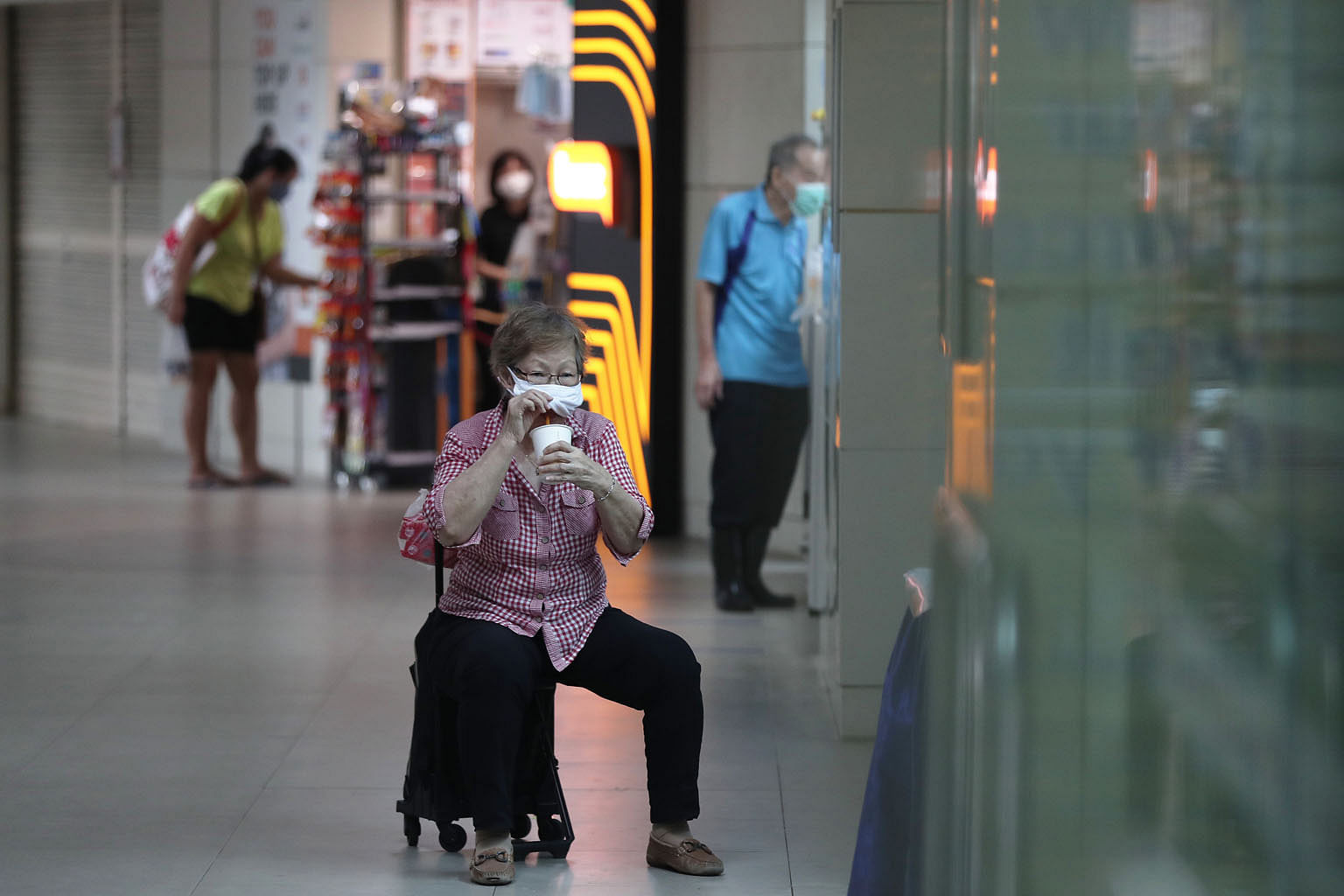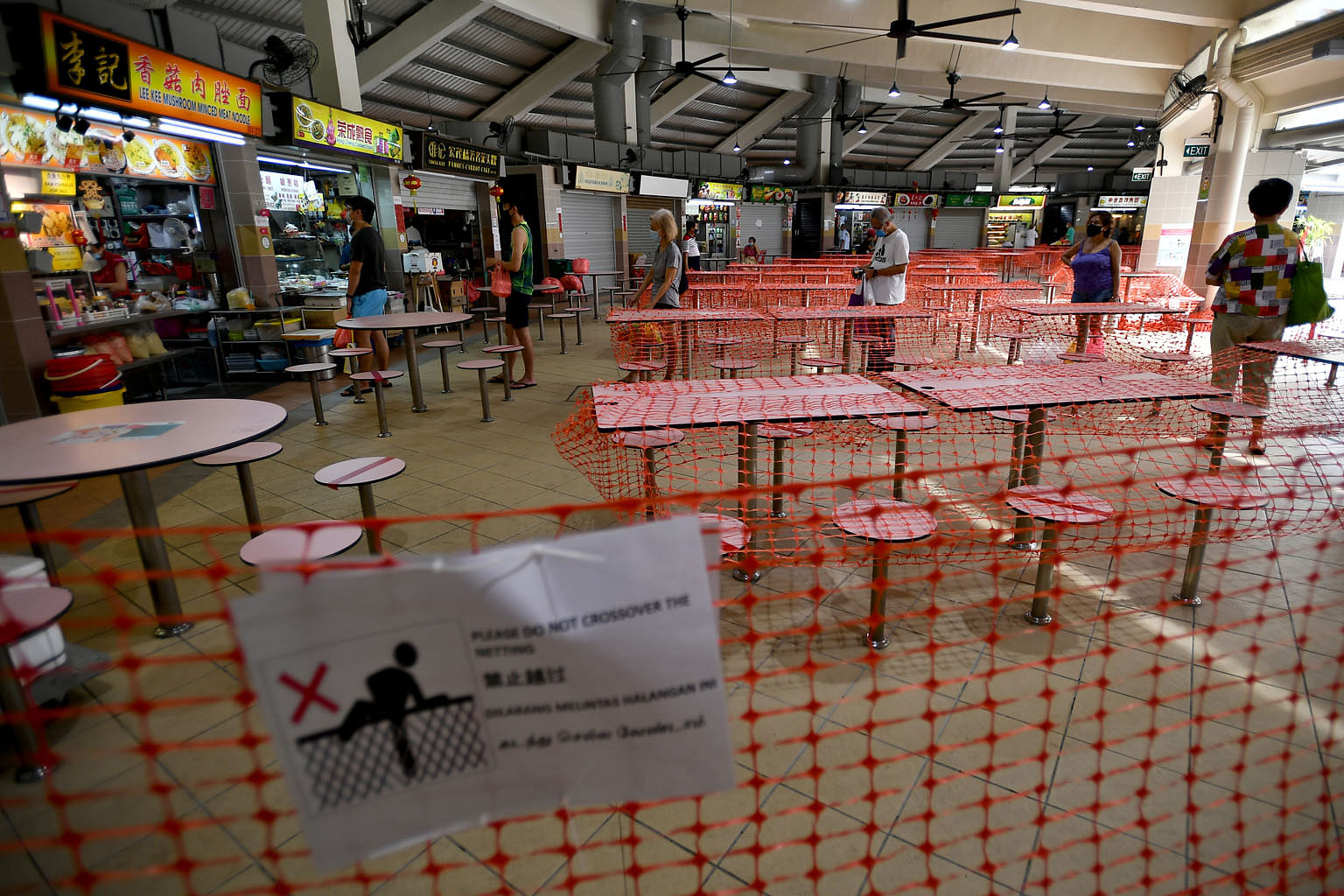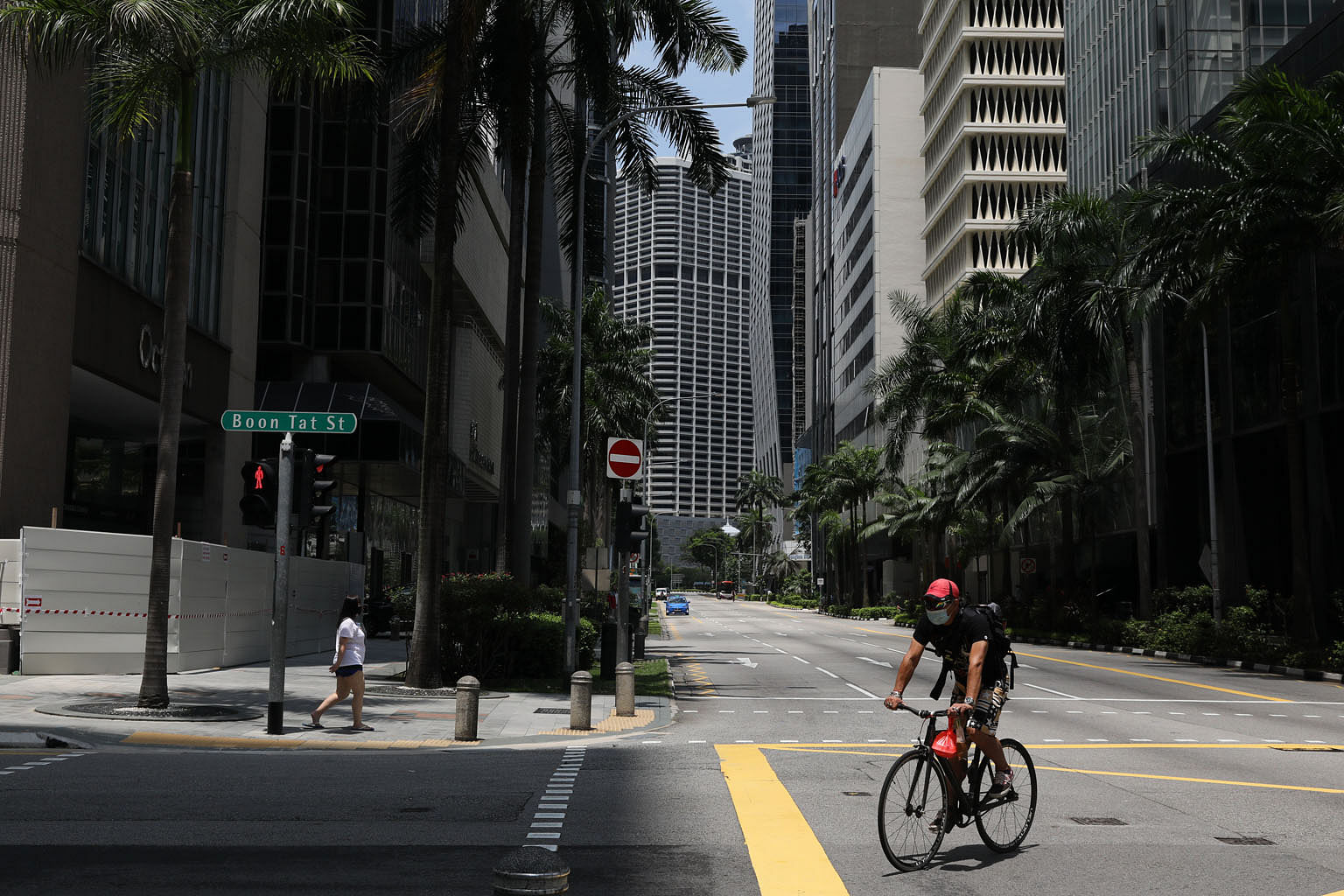Just over 100 days ago, on Jan 15, the United States and China signed their phase one trade agreement, agreeing to halve some tariffs and suspend others, which kindled hopes that the two-year-long US-China trade war might be winding down.
Singapore's economy had been battered by the spillovers, its exports hobbled by disrupted supply chains and its growth plunging to a decade low of 0.7 per cent last year, compared with 3.4 per cent in 2018.
By early January, there were also signs that the downturn in the electronics sector, which accounts for more than 43 per cent of Singapore's manufacturing value-added, was bottoming out. There was an emerging sense of relief that the worst might be over for the economy.
Last November, the Ministry of Trade and Industry (MTI) forecast growth this year at 0.5 per cent to 2.5 per cent, the midpoint of 1.5 per cent being more than double the growth last year.
Then came Covid-19.
The disease had been spreading in Wuhan, the capital of China's Hubei province, since November. With news of the outbreak initially suppressed, it was nowhere on policymakers' horizons until Jan 2, when the Ministry of Health (MOH) announced that it would start screening passengers flying in from Wuhan. On Jan 23, Singapore had its first confirmed case - a 66-year-old Chinese national who had arrived three days before.
That was the start of a harrowing period for Singapore's health system, its society and its economy.
The case numbers rose rapidly: seven by Jan 28, 18 by Feb 1, and 33 by Feb 7, when the MOH raised the Disease Outbreak Response System Condition level to orange from yellow, which entailed a tightening of precautionary measures, such as encouraging more telecommuting, the cancellation of large-scale events and the suspension of school activities.
On Feb 17, the MTI cut its gross domestic product (GDP) growth forecast for this year to a range of minus 0.5 per cent to 1.5 per cent. It would not be the last downward revision in the forecast.
By then, China's lockdown of Wuhan and Hubei province, as well as other areas of the country to which the virus had spread, had already disrupted production and supply chains.
Singapore's manufacturing and wholesale trading sectors started feeling the impact as China's factories closed, imports of vital inputs were interrupted and regional trade started slowing. Tourism from China - the top source of inbound visitors to Singapore, accounting for 18 per cent of tourist arrivals last year - ground to a halt. Airlines, hotels and restaurants were immediately hit.
SUPPORTING JOBS AND COMPANIES
On Feb 18, Finance Minister Heng Swee Keat announced his first Budget of the year. Called the Unity Budget, it allocated $800 million to the MOH to help fight the Covid-19 outbreak. It also contained a $4 billion Stabilisation and Support Package aimed at protecting jobs. One of its highlights was a Jobs Support Scheme, under which the Government would subsidise 8 per cent of all companies' wages up to a monthly wage cap of $3,600 for three months. To help companies with cash flow and access to credit, Mr Heng granted a 25 per cent corporate income tax rebate and enhanced working capital loans, increasing the Government's risk-share to 80 per cent from 50 per cent to 70 per cent previously.
The worst-hit sectors - tourism, aviation, retail, food services and point-to-point transport - got additional help, including bridging loans, rental waivers and property tax rebates. Mr Heng also set aside $1.6 billion to help Singaporeans with their household expenses. Those aged 25 and above got a $500 top-up of SkillsFuture credits, while companies were offered subsidies to defray 90 per cent of costs related to training and business transformation.
Over the next few days, infections continued to go up. By the end of February, there were 100 cases of Covid-19 in Singapore. With the disease having spread to South Korea, Japan, Iran and Italy, inbound travel from these countries was stopped.
The Government announced a series of measures, essential for public health, but damaging for the economy. They included safe distancing, which advised people to keep at least 1m away from one another at all places; the cancellation of events with more than 250 participants; stay-home notices, previously applicable to travellers from China, were expanded to cover those from Japan, Switzerland, Britain and Asean; and advisories to discourage foreign travel.

A SECOND PACKAGE
At an ST-BT Roundtable on the Budget on March 11, Mr Heng revealed that the Government was working on a second package to cushion the economy from the spreading collateral damage wrought by the public health restrictions, as well as external supply shocks. Its topmost concern was enabling workers to keep their jobs so that consumption could resume when the economy got back on track.
The next day, Prime Minister Lee Hsien Loong warned that Covid-19 would be around for "a year and maybe longer".
Mr Heng presented his second Budget, called the Resilience Budget, on March 26. That morning, MTI further downgraded its GDP growth forecast for this year to a range of minus 1 per cent to minus 4 per cent, confirming that a recession was certain.
Noting that the Covid-19 outbreak had "escalated quickly", Mr Heng pointed out that it had impacted "broad swathes of our economy, with some more affected than others". The economy faced its worst contraction since independence, he said, which called for "extraordinary measures".
He introduced a spending package worth $48 billion, which, together with measures in the previous Budget, meant that the Government had by then committed a total of almost $55 billion in support, equivalent to about 11 per cent of GDP - the biggest budgetary outlay in Singapore's history.
The measures were broad-based. The wage subsidies under the Jobs Support Scheme were tripled to 25 per cent, from 8 per cent, and extended till the end of this year. The monthly qualifying wage ceiling was also raised to $4,600 from $3,600. The hardest-hit sectors - aviation and tourism-related industries - got a wage subsidy of 75 per cent, while the food services sector got a subsidy of 50 per cent.
For the self-employed, there was direct cash assistance of $1,000 per month for nine months. There was also more income support for low-income workers, a traineeship programme for job seekers, $145 million to help the unemployed and an additional $4.6 billion in assistance to households.
For companies, there was a raft of measures to ease cash flow and cut costs, including a deferral of income tax payments, a freezing of all government fees and charges for one year and more generous property tax rebates, including zero tax for those worst affected by the outbreak, such as hotels, restaurants and shops. There was special support for certain sectors, including $350 million for aviation, $90 million for tourism and $55 million for arts and culture.
There were also enhancements to government loan and financing schemes, so that even the hardest-hit businesses could have access to credit. Later, Law Minister K. Shanmugam announced measures to temporarily relieve people and companies from certain legal obligations relating to payments that could not be made because of the Covid-19 crisis.
MONETARY EASING
With economic growth weakening and inflation on a declining trend, the Monetary Authority of Singapore (MAS) eased its monetary policy stance. On March 30, it announced that it would flatten the slope of its policy band for the Singapore dollar's value against a basket of currencies, starting at the prevailing level of the dollar's value, which had already weakened to slightly below the midpoint of the policy band. This was the first time the MAS had both flattened the slope of the policy band and permitted its downward adjustment. But it left unchanged the width of the policy band, which determines how much the currency can fluctuate. The MAS also lowered its 2020 forecasts for both core inflation (which excludes energy and food prices) and overall inflation to a range of minus 1 per cent to 0 per cent (from its previous forecast of 0.5 per cent to 1.5 per cent), indicating that the weakening of the Singapore dollar did not presage a rise in inflation.

With new daily cases of Covid-19 rising to around 50 a day in the second half of March, compared with about 10 previously, PM Lee announced in his third address to the nation on April 3 that from April 7 until tomorrow, a circuit breaker would be put in place to pre-empt escalating infections. This would entail the closure of most workplaces except essential services and tighter restrictions on the movement and gathering of people.
Acknowledging that "this will impact our workers and businesses severely", he said that Mr Heng would soon announce additional support measures over and above what was provided in the two earlier Budgets. The Government would also legislate to require landlords to pass on property tax rebates to their tenants - which some were resisting doing - and to enable businesses and companies to defer some contractual obligations such as paying rent, repaying loans or completing jobs.
SCALING UP SUPPORT
Mr Heng's third Budget - the Solidarity Budget - came on April 6. In measures totalling $5.1 billion, he further raised the level of support for companies and workers. For companies, he extended the wage subsidy for all firms to 75 per cent of gross monthly wages for the first $4,600 of wages paid last month for each local employee. Previously this level of support was extended to only certain front-line sectors, but with the economic crisis having spread to almost every sector of the economy, it would now cover all of the more than 1.9 million local workers.

As a further cost-cutting measure, he waived the monthly foreign worker levy due from companies last month, plus provided a rebate of $750 for each work permit or S-Pass holder based on previous levies paid this year. And to ease credit conditions, he raised the Government's risk-share of loans under certain financing schemes from 80 per cent to 90 per cent for all such loans initiated from April 8 until March 31 next year.
Mr Heng also extended support to a wider group of the self-employed, including those who live in some condominiums and private properties. For individuals, Mr Heng pledged a one-time payment of $600 in cash to all adult Singaporeans, up from $300 previously.
With Covid-19 infections accelerating through the first three weeks of last month, mainly in foreign worker dormitories, the Government announced that the circuit breaker would be extended another month, until June 1. Given that this would prolong the damage to the economy, Mr Heng announced that the 75 per cent wage subsidies under the Jobs Credit Scheme, as well as the suspension of foreign worker levies and the $750 per worker rebates on past levies, would be extended through this month.
The latest package will cost an additional $3.8 billion, which brings Singapore's total budgetary support to $63.7 billion, or 12.6 per cent of GDP, and a Budget deficit of 9.6 per cent of GDP, the largest in its post-independence history. The Government will need to draw on almost $26 billion of its past reserves to fund its support measures. But as Mr Heng pointed out, "the Covid-19 pandemic and the multiple threats that it poses to our nation is the sort of event we have accumulated reserves for".

In the coming months, even more support may be needed, depending on how the pandemic plays out, given that many of the measures - including the Jobs Support Scheme - are time-bound. In its latest update to its World Economic Outlook last month, the International Monetary Fund expects the global economy to shrink by 3 per cent in the worst recession since the Great Depression of the 1930s.
With advance estimates showing that Singapore's growth in the first quarter of this year contracted by 2.2 per cent year on year, some observers, including Trade and Industry Minister Chan Chun Sing, suggest that GDP could decline by even more than the lower end of the Government's forecast of minus 4 per cent this year. The MAS has cautioned that the economic outlook is subject to "significant downside risks". DBS Bank has forecast that the economy will contract by 5.7 per cent.
A DIFFERENT ECONOMY
With a vaccine against Covid-19 still a distant prospect, some experts, such as Professor Teo Yik Ying, dean of the Saw Swee Hock School of Public Health at the National University of Singapore, have flagged the possibility that the circuit breakers, which curtail economic activity, may need to be switched on and off every few months.
Despite the Government's unprecedented support measures, economists warn of severe job losses, as exports are hit by falling global demand, companies struggle to survive and consumers cut back on discretionary purchases.
Of late, there have been signs that Singapore's circuit breakers are working. While infections in foreign worker dormitories remain high, those in the rest of the community have been decreasing in recent days. But even after the circuit breaker is lifted, the economy is unlikely to fully light up; the effect will be more like that of a dimmer switch turned up slightly - companies and consumers will need time to rebuild their resources and their confidence to invest and spend. The reopening of the economy may also be a stop-go process if infections flare up as social distancing rules ease.
Eventually - but we don't know when - there will be a recovery and it could be robust. But by then, many companies will have gone, new ones will have emerged, some industries will have been transformed and working arrangements changed.
Meanwhile, the Government may need to provide even more fiscal support and re-examine its policies relating to both social safety nets as well as foreign workers and their living conditions, which will impact costs. Later, it will need to rebuild its public finances.
The economy will never be the same as it was 100 days ago.

